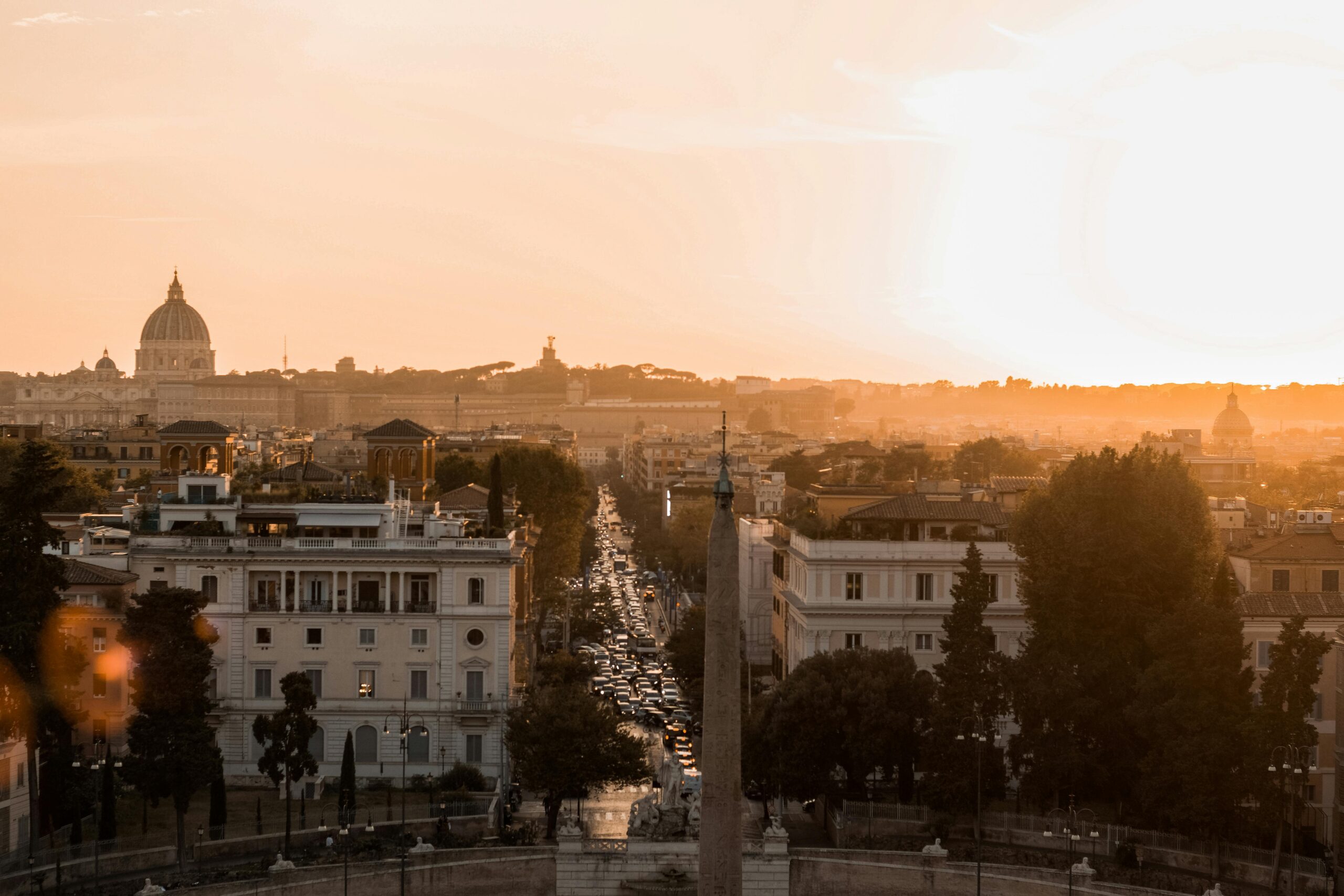
Itinerary in Rome
Pilgrimage of the Seven Churches
The pilgrimage of the ‘Seven Churches’, originally conceived by St Philip Neri in the 16th century, is one of the oldest Roman traditions. It involves a walk of about 25 km which snakes through the whole city, reaching out to the Roman countryside, the catacombs and stops at some of Rome’s magnificent basilicas.
St Peter’s Basilica
According to tradition the tomb in which the Apostle Peter was buried after his crucifixion was situated here, on the highest point of Vatican Hill, and so it was on this spot, in the 4th century, that Emperor Constantine decided to build the basilica, the first to be dedicated to the Saint.
During the High Middle Ages, this place of worship became the main pilgrimage destination of the Western world. In 1506, Pope Julius II decided to demolish the original structure to replace it with a larger and grander worship space.
Some of the greatest artists in history were involved in the construction and decoration of this hugely impressive basilica: Bramante, Raphael, and Michelangelo among others. In 1629 Bernini finished the internal decoration of the whole church, creating its present look.
The Basilica of St John Lateran
The Archbasilica of The Most Holy Saviour and of Saints John the Baptist and the Evangelist, commonly known as St John Lateran, is situated in the area of the Caelian Hill.
Originally, before the construction of the basilica, the ancient family of the Laterani owned the area, and lived nearby. The Annales of Tacitus in the year 65 AD record a confiscation of the land by the Emperor Nero, due to the involvement of some members of the family in a plot against him.
The land subsequently passed into the possession of a certain Fausta, the wife of Flavius Valerius Constantinus, who after the death of his father in 306 was proclaimed emperor.
Emperor Constantine – through the Edict of Milan – gave freedom of worship to the Christian community in 313. So as to give the nascent Church a suitable place for celebrating its feasts, he gave to Pope Melchiades the lands of the Lateran estate, that had come to him as part of his wife’s dowry, in order that the Pope might build a church there.
The Basilica, consecrated in 324 by Pope Sylvester I, was dedicated to The Most Holy Saviour. In the 9th century Pope Sergius III also dedicated it to Saint John the Baptist and in the 12th century Pope Lucius II added Saint John the Evangelist to the title.
From the 4th to the 14th century, when the pope moved to Avignon, the Lateran was the main seat of the papacy, thus becoming the symbol and the heart of the Church’s life.
In 1378, with the election of Gregory XI, the see of the pontiff returned to Rome, but the Pope decided to move the seat of power to the Vatican, since the Lateran was in very poor condition.
In 1650, Pope Innocent X commissioned a wholesale reconstruction the Basilica, entrusting the work to Francesco Borromini.
The Basilica of St Paul Outside-the-Walls
After the edict of Milan of 313, which granted Christians freedom of worship, Emperor Constantine decided to donate two basilicas to the new nascent Church, erected on the tombs of Saints Peter and Paul.
However, in the 5th century, the three reigning emperors of the time, Theodosius, Valentinian II and Arcadius, seeing that the constant flow of pilgrims was too much for the original basilica to cope with, had to construct a larger building. In doing so the orientation of the basilica was changed so that it faced west.
It was only in 1854 that Pope Pius IX inaugurated the present monumental basilica which contains the chain, which, according to tradition, bound the Apostle Paul to the Roman Soldier who was guarding him while he was imprisoned awaiting trial.
The Basilica of St Mary Major
The Papal Basilica of St Mary Major (Santa Maria Maggiore) is the oldest and most important Marian sanctuary in Western Christendom and is the only one of the Papal Basilicas to have maintained its early Christian appearance.
Although it has been embellished and extended over the years all the commissioning patrons have respected its original layout and design, which, according to tradition, was divinely inspired.
According to the traditional story of its foundation, the Virgin Mary appeared in a dream to the Patrician John and Pope Liberius, exhorting them to build a church dedicated to her on the exact spot where she would cause snow to fall. On the morning of 5 August in the year 358, snow was seen on the Esquiline Hill, the highest of Rome’s hills, outlining the perimeter of what was to become the new church.
Today that miraculous snowfall is still remembered when white rose petals fall from the ceiling of the Basilica during the feast day liturgy. This tradition gives a special nobility to St Mary Major’s – marking it out as a kind of Marian relic, a place that was desired and planned by the Mother of God herself.
The Basilica is home to the most important of all Marian icons, the Salus Populi Romani (Our Lady Saviour of the Roman People). Tradition attributes the artwork to St Luke the Evangelist and patron of painters.
Pope Francis places all his apostolic journeys under the protection of Our Lady, Salus Populi Romani, stopping off to pray at the icon before his departure from Rome and again on his return.
The relic of the holy crib, the bedding on which the baby Jesus was laid, which is under the Papal altar, recalls the importance of the Basilica as the ‘Bethlehem of the West’. Here, the first Christmas Midnight Mass was celebrated and for centuries the Popes came here to carry on that tradition.
Among the other important relics contained within the basilica are the mortal remains of St Matthew and St Jerome.
It was in St Mary Major’s that Pope Adrian II welcomed, in the year 867, Saints Cyril and Methodius and approved the use of the Slavic texts in the liturgy. Also worthy of note is that fact that seven Popes are buried in the Basilica of St Mary Major.
The Pilgermage Iter Europeum
Maltese Catholic Church in Rome – San Paolo alle Tre Fontane
The itinerary of ‘Churches of the European Union’, from the Latin “Iter Europaeum”, includes stops in 28 churches and basilicas that are all historically linked to European countries either for cultural or artistic reasons or because of their historic tradition of welcoming pilgrims from a particular state of the European Union.
‘The Church of San Paolo in the Three Fountains’ area is associated with Malta as part of the itinerary. The Church of St Paul at the Three Fountains was erected in the 5th century on the site where, according to tradition, St. Paul was martyred by beheading. At the site, a plaque reads, “S. PAULI APOSTOLI MARTYRII LOCUS UBI TRES FONTES MIRABILITER ERUPERUNT”, recalling ‘the place of the martyrdom of St. Paul the Apostle where three springs miraculously sprang up’.
The same tradition suggests that the apostle’s head, after being cut off, bounced three times on the ground before coming to a halt. From those three points in the ground then flowed three springs of water: the first hot, the second warm, and the third cold. Three little buildings were erected to mark the miracle that had occurred. For many centuries the water was distributed to the faithful because it was believed to have miraculous properties for the healing of diseases, but in 1950, due to contamination, the fountains were closed off.
The church that can be seen today was built by the architect Giacomo Della Porta in 1599 and commissioned by Cardinal Pietro Aldobrandini.
The Maltese pilgrims are encouraged to visit this church during their pilgrimage to Rome.
The Pilgrim Card
The Pilgrim Card is a free digital pass bearing the name of the holder which will be needed to take part in the main Jubilee events and to organise a pilgrimage to the Holy Door.
The Pilgrim’s Card may be obtained by signing up here or via the official Jubilee application. After entering the required details, the pilgrim will receive a unique QR code and a personalised account on the app.
With the Pilgrim’s Card, one can sign up for pilgrimages to the Holy Door of Saint Peter’s Basilica and all the other main events of the Jubilee and include details of any disabilities or special access requirements. During main Jubilee events where large numbers are expected in attendance, obtaining a card will facilitate access, as well as allow pilgrims to modify or cancel bookings.
